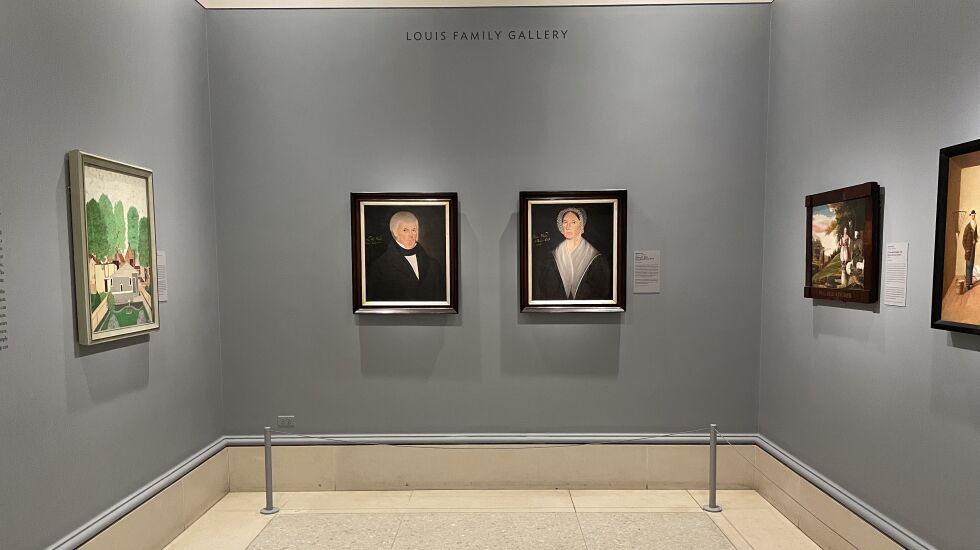

This has been a good year for me and major museums.
One glorious day at the Prado in Madrid, including half an hour gazing at Hieronymus Bosch’s “Garden of Earthly Delights,” which I’d previously only seen as a square inch detail in textbooks. In reality, it’s 12 feet across and almost seven feet high. Then in September, a day at the Rijksmuseum in Amsterdam. Four, count ’em, four Vermeers.
Despite inhaling all this high-octane artwork, it’s always good to come back to Chicago to the Art Institute, a world class institution by any measure. My wife and I are members, which means we can stroll in anytime we like and wander around. And I do, literally if I have an hour to kill and am in the vicinity.
So I’m trucking into the American wing not long ago, and I notice this little niche, with room for five paintings. Something new.
“Folk Art and Belonging” announces a sign. The text explains that folk art — also called “vernacular art” — is a wide range of creative endeavors, from handmade jugs to embroidered samplers to amateur portraiture.
“Museums often present vernacular traditions as separate from the larger histories of art,” it says. “Embracing a more expansive vision of the arts, we are rethinking this approach. ... We likewise plan to reintegrate such artwork throughout the galleries downstairs as part of a major reinstallation in the coming years.”
Golly. What does THAT mean? “Let’s put a potholder next to this Rembrandt”? Seeking clarity, I emailed the Art Institute and, since they can ... um, how to say this nicely? ... take a while to find somebody who can speak words in public, I also reached out to the Cleveland Museum of Art, as a control.
Cleveland leapt from the blocks.
“In the Cleveland Museum of Art’s Strategic Plan, we prioritized diversifying the collection to include more important works by historically underrepresented artists including BIPOC and women artists,” said deputy director and chief curator Heather Lemonedes Brown. “By expanding the scope of our world-class collection, we help all audiences see themselves, as well as discover the culture of others in our galleries.”
I thought I was fairly fluent in woke, but “BIPOC” was new for me, so I imagine it could be new for some of you, too. “Black, Indigenous, and people of color.” Pronounced “bye-pock.”
I also contacted Intuit: The Center for Intuitive and Outsider Art, a hidden Chicago gem. As their name suggests, folk art is their bailiwick, and appropriate to their smallness and scrappiness, Intuit’s CEO, Debra Kerr, actually phoned.
“Part of the story here, in recent years, mainstream art museums have begun to embrace self-taught, outsider artists as a legitimate genre,” she said. “It’s very encouraging to see museums all over the country and in other parts of the world embracing this.”
Museums are trying to pivot from art warehouses to forces for inclusivity.
“My personal focus is on the role museums can and should be playing in social good and social justice,” she said, adding that until 2010 museums were trying to “stay neutral.” But now “museums are having conferences on how to be more relevant. This is a role museums have embraced.”
Some more down low than others. The Art Institute might hesitate to speak for itself, but Kerr gives them credit.
“They did that big Joseph Yoakum show,” she said. “They own some Henry Dargers.” (Darger was a reclusive Chicago janitor whose transgender “Vivian girls” drawings are stars of the collection at Intuit, which is closed until late 2024 while the museum triples in size).
The Art Institute also went big in 2021 for textual artist Barbara Kruger and technicolor quiltist Bisa Butler.
“Before people feel welcome at a place, the place first has to welcome them,” a Chicago critic wrote at the time.
OK, that was me. And I distinctly remember looking around at the crowds and thinking, “THIS is a welcome change of pace ...”
I hope the Art Institute doesn’t get offended; I chide because I love. I feel it’s my museum and just wish the management were half as bold as the artworks on the walls. Remember the quotidian nature of this column. Just because you missed the bus this time — I waited nine days, with reminders, and rien, as Degas would say — doesn’t mean there isn’t another around the corner. I’m sure somebody there knows something about all this. Am I right?







